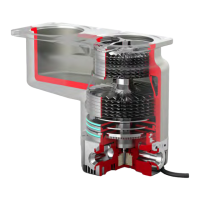If the power limit seng is not adjus
table, use a power supply capable to supply
sucient current to meet manufacturer's factory default power limit seng shown in
Table: Logic interface technical data on page 27.
The manufacturer's TIC has variants. If the pump is operated using the
manufacturer's TIC, contact us to select the applicable variant for the applicaon.
3.7 Pumping media
WARNING: DANGEROUS GASES
Risk of asph
yxiaon. Release the dangerous gases and gas mixtures safely. Do not
expose people to the gases. If hazardous gases or vapour must pump, obey the safety
recommendaons of the supplier of the gas or vapour.
WARNING: PYROPHORIC OR EXPLOSIVE GASES
Risk of e
xplosion. Do not use the nEXT pump to pump pyrophoric or explosive gas
mixtures as the pump is not applicable for this purpose. The pump and its
connecons are not designed to contain an explosion.
WARNING: DANGEROUS GASES
Risk of damag
e to equipment. In the interstage and booster versions of the
nEXT pumps, gas pumped through the interstage port will mix with gas pumped
through the pump inlet. Make sure that the gases do not react or combine to form
dangerous gases and substances.
WARNING: HIGH OPERATING PRESSURE
Risk of damag
e to equipment. Do not exceed the maximum connuous operang
pressure. Failure to do so can cause dangerous rotor temperatures and will decrease
the life of the pump.
WARNING: VACUUM EXPOSURE
Risk of injur
y. Do not expose the part of the human body to the vacuum.
WARNING: MERCURY VAPOUR
Risk of damag
e to equipment. Do not use a nEXT pump to pump mercury vapour. Do
not allow mercury (for example, from a McLeod gauge) to come in contact with the
pump. If mercury vapour is pumped, the pump rotor can corrode and fail.
Note:
Conc
entraons of gases can be changed by the compression of the pump.
The pumps are designed to pump the residual gases used in high‑vacuum systems are:
▪ Air
Page 25
B85200880_D - Technical data

